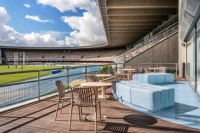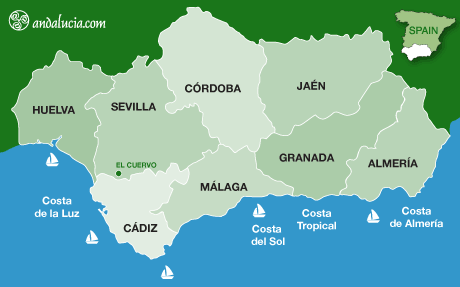EL CUERVO DE SEVILLA
by Saskia Mier
El Cuervo de Sevilla was given its name during the Middle Ages and has not since changed. It has about 8,600 inhabitants.
HISTORY
During the Middle Ages, the settlement was known as El Cuervo with Alfonso X "El Sabio" himself mentioning it in the Repartimientos of land in the year 1274. From the vestiges found in its surroundings it is known that here were settled primitive cultures.
During the Roman era it was directly related to the worship of water and was attributed medicinal properties. In the Sierra de Gibalbín, about 3km east of El Cuervo, there was a large Roman city and numerous villas around the Roman road 'Via Augusta', what today is the National Road IV. It was built by Octavio Augustus in the first century, also called Via Herculea that united Rome with Cadiz.
As a passing village on the Via Augusta, refuelling stops and accommodation for travellers and their animals were built, known as Casas de Postas. One of these dates from the eighteenth century, but it is thought that the present constructions are based on others more ancient.
Due to its situation, the area demanded a lot of temporary work, bringing in the first immigrants from neighbouring towns. These immigrants worked in the cortijos, later settling in the village.
THINGS TO SEE
La Casa de Postas
The oldest building in El Cuervo, dating from the eighteenth century with an area of 2,016.40m², of which 1,260m² are built and 756.40m² are interior patios. It was used as a rest stop to replenish forces, change horses and eat, by travellers on the route from Cadiz and Seville to Madrid. The house of rural architecture was visited by illustrious figures of the time like, the Kings, Carlos IV and Fernando VII, and the Infanta Maria Luisa Fernanda. Located on Avenida de Jerez.
Iglesia Parroquial de San José
The church was built in 1928 and keeps the image of the Patroness of El Cuervo, the Virgen del Rosario, a carving of the eighteenth century that was brought from a Convent of cloistered nuns in the Cadiz town of, Arcos de la Frontera. Located on Avenida de Jerez.
Hotels in Quentar
Book Hotels in Quentar
THINGS TO SEE OUTSIDE THE VILLAGE
Ermita Nuestra Señora del Rosario
The chapel was built in the 1970s. Located in Parque Rocío de La Cámara.
NATURAL SPACES
Parque Rocío de La Cámara
The natural park has more than 60,000m². The Town Hall bought fifteen hectares to give residents a recreational area enclosed by fences and gates that are always open. Although the circulation of cars inside is prohibited, entry with the vehicle is allowed. Apart from oak, other Mediterranean trees have been planted to increase the shade. It has garbage collection, playgrounds, tables, barbecues, drinking fountains, a natural classroom and several play areas. It is the ideal place for children to play. Located east of El Cuervo de Sevilla, on Camino de las Monjas.
Laguna de los Tollos
The lagoon has an extension of 83.7 hectares and is the third most important lagoon in Andalusia and the second largest in width. It is a wetland originated by karst dissolution in triassic saline materials and the natural flood surface is partially filled by the tailings of a mining operation. In the sector affected by the extractive activities there have been two residual lagoons, formed in deep holes of extraction, that maintain permanent waters by the discharges of groundwater, acting like sinks. The lagoon has become extremely in flora and fauna. Located south east of El Cuervo, off the Carretera Rural G-7.
GASTRONOMY
The traveller who wants to taste the most typical dishes of El Cuervo gastronomy, should try the ajo frito or ajo de espárragos (fried garlic or garlic asparagus, accompanied by raw green radishes, olives or peppers). Sweet treats include the traditional rosquete.
FESTIVALS
Cabalgata Reyes Magos
Three Kings procession celebrated on the evening of 5 January.
Carnaval
Celebrated in February.
Semana Santa
Holy Week.
El Día del Pan
Celebrated in April.
Romería
Celebrated the last weekend of May.
Feria
Celebrated the 7 October.
NEXT PLACES
The next villages to El Cuervo de Sevilla are Lebrija, Las Cabezas de San Juan and Jerez.

